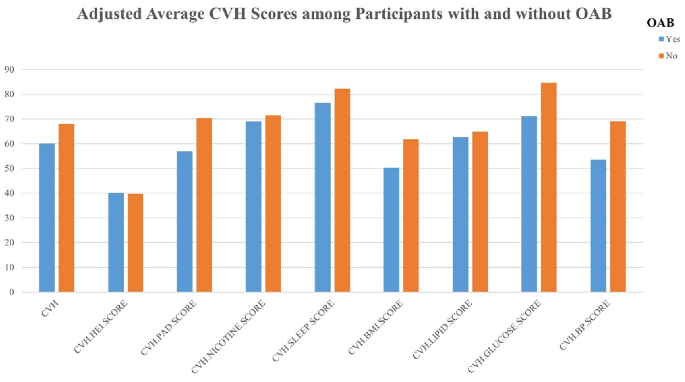
Xiao, Y. et al. A positive association between food insecurity and the prevalence of overactive bladder in U.S. adults. Front. Nutr. 10, 1329687 (2024).
Chen, H., Hoi, M. P. M. & Lee, S. M. Y. Medicinal plants and natural products for treating overactive bladder. Chin. Med. 19, 56 (2024).
Funada, S. et al. Multicomponent intervention for overactive bladder in women: A randomized clinical trial. JAMA Netw. Open 7, e241784 (2024).
Hagovska, M. et al. The relationship between overweight and overactive bladder symptoms. Obes. Facts 13, 297–306 (2020).
Bozkurt, Y. E., Temeltaş, G., Müezzinoğlu, T. & Üçer, O. Mediterranean diet and overactive bladder. Int. Neurourol. J. 26, 129–134 (2022).
Kawahara, T., Ito, H., Yao, M. & Uemura, H. Impact of smoking habit on overactive bladder symptoms and incontinence in women. Int. J. Urol. 27, 1078–1086 (2020).
Noh, J.-W., Yoo, K.-B., Kim, K.-B., Kim, J. H. & Kwon, Y. D. Association between lower urinary tract symptoms and cigarette smoking or alcohol drinking. Transl. Androl. Urol. 9, 312–321 (2020).
Smith, L. et al. The association between physical activity and urinary incontinence among adults residing in Spain. Sci. Sports 38, 411–418 (2023).
Ge, T. J., Vetter, J. & Lai, H. H. Sleep disturbance and fatigue are associated with more severe urinary incontinence and overactive bladder symptoms. Urology 109, 67–73 (2017).
Wang, C.-C., Jiang, Y.-H. & Kuo, H.-C. The pharmacological mechanism of diabetes mellitus-associated overactive bladder and its treatment with botulinum toxin A. Toxins (Basel) 12, 186 (2020).
Akbar, A. et al. Association of overactive bladder with hypertension and blood pressure control: The multi-ethnic study of atherosclerosis (MESA). Am. J. Hypertens. 35, 22–30 (2021).
Garnica, S. V., Minassian, V. A., Platte, R. O. & Sartorius, J. Overactive bladder and hyperlipidemia: Is there an association?. Female Pelvic Med. Reconstr. Surg. 17, 76–79 (2011).
Lloyd-Jones, D. M. et al. Life’s essential 8: Updating and enhancing the American Heart Association’s construct of cardiovascular health: A presidential advisory from the American Heart Association. Circulation 146, e18–e43 (2022).
Gou, R., Chang, X., Li, Z., Pan, Y. & Li, G. Association of life’s essential 8 with osteoarthritis in United States adults: Mediating effects of dietary intake of live microbes. Front. Med. (Lausanne) 10, 1297482 (2023).
Zeng, G., Lin, Y., Lin, J., He, Y. & Wei, J. Association of cardiovascular health using life’s essential 8 with depression: Findings from NHANES 2007–2018. Gen. Hosp. Psychiatry 87, 60–67 (2024).
von Elm, E. et al. Strengthening the reporting of observational studies in epidemiology (STROBE) statement: Guidelines for reporting observational studies. BMJ 335, 806–808 (2007).
NHANES Data Release and Access Policy.
Wang, L., Yi, J., Guo, X. & Ren, X. Associations between life’s essential 8 and non-alcoholic fatty liver disease among US adults. J. Transl. Med. 20, 616 (2022).
Zhu, S., Wang, Z., Tao, Z., Wang, S. & Wang, Z. Relationship between marijuana use and overactive bladder (OAB): A cross-sectional research of NHANES 2005 to 2018. Am J Med 136, 72–78 (2023).
Blaivas, J. G., Panagopoulos, G., Weiss, J. P. & Somaroo, C. Validation of the overactive bladder symptom score. J. Urol. 178, 543–547 (2007).
Song, W. et al. The role of sarcopenia in overactive bladder in adults in the United States: Retrospective analysis of NHANES 2011–2018. J. Nutr. Health Aging 27, 734–740 (2023).
Lin, W., Wang, H., Wu, Z., Zhang, W. & Lin, M.-E. Associations between exposure to organophosphate esters and overactive bladder in U.S. adults: A cross-sectional study. Front. Public Health 11, 1186848 (2023).
Kilinc, M. F., Yasar, E., Aydin, H. I., Yildiz, Y. & Doluoglu, O. G. Association between coronary artery disease severity and overactive bladder in geriatric patients. World J. Urol. 36, 35–40 (2018).
Ceyhun, G. & Erbay, G. Relationship between the severity of coronary artery disease and overactive bladder. Acta Cardiol. Sin. 37, 254–260 (2021).
Lu, Z. et al. Associations between overactive bladder and sleep patterns: A cross-sectional study based on 2007–2014 NHANES. BMC Urol. 23, 184 (2023).
Malhotra, A. & Loscalzo, J. Sleep and cardiovascular disease: An overview. Prog. Cardiovasc. Dis. 51, 279–284 (2009).
Hsu, L.-N., Hu, J.-C., Chen, P.-Y., Lee, W.-C. & Chuang, Y.-C. Metabolic syndrome and overactive bladder syndrome may share common pathophysiologies. Biomedicines 10, 1957 (2022).
Tune, J. D., Goodwill, A. G., Sassoon, D. J. & Mather, K. J. Cardiovascular consequences of metabolic syndrome. Transl. Res. 183, 57–70 (2017).
Przydacz, M., Dudek, P. & Chlosta, P. Prevalence, bother and treatment behavior related to lower urinary tract symptoms and overactive bladder among cardiology patients. J. Clin. Med. 9, 4102 (2020).
Chiu, A.-F. et al. High classification of chronic heart failure increases risk of overactive bladder syndrome and lower urinary tract symptoms. Urology 79, 260–265 (2012).
Ekundayo, O. J. The association between overactive bladder and diuretic use in the elderly. Curr. Urol. Rep. 10, 434–440 (2009).
Wu, Y.-H. et al. Bladder hyperactivity induced by oxidative stress and bladder ischemia: A review of treatment strategies with antioxidants. Int. J. Mol. Sci. 22, 6014 (2021).
Isik, B., Ceylan, A. & Isik, R. Oxidative stress in smokers and non-smokers. Inhal. Toxicol. 19, 767–769 (2007).
Miljkovic, M. et al. Association of dyslipidemia, oxidative stress, and inflammation with redox status in VLDL, LDL, and HDL lipoproteins in patients with renal disease. Angiology 69, 861–870 (2018).
Atrooz, F. & Salim, S. Sleep deprivation, oxidative stress and inflammation. Adv. Protein Chem. Struct. Biol. 119, 309–336 (2020).
Oguntibeju, O. O. Type 2 diabetes mellitus, oxidative stress and inflammation: Examining the links. Int. J. Physiol. Pathophysiol. Pharmacol. 11, 45–63 (2019).
Marseglia, L. et al. Oxidative stress in obesity: A critical component in human diseases. Int. J. Mol. Sci. 16, 378–400 (2014).
Ren, Y. et al. Associations between life’s essential 8 and chronic kidney disease. J. Am. Heart Assoc. 12, e030564 (2023).
- The Renal Warrior Project. Join Now
- Source: https://www.nature.com/articles/s41598-024-62842-1
